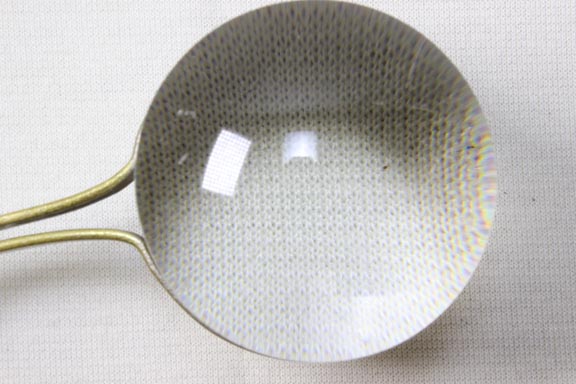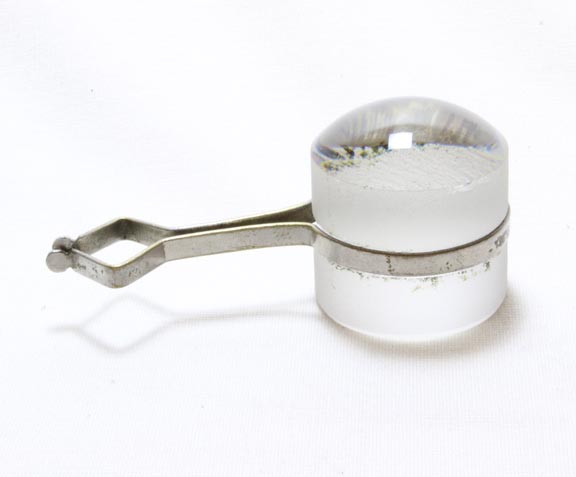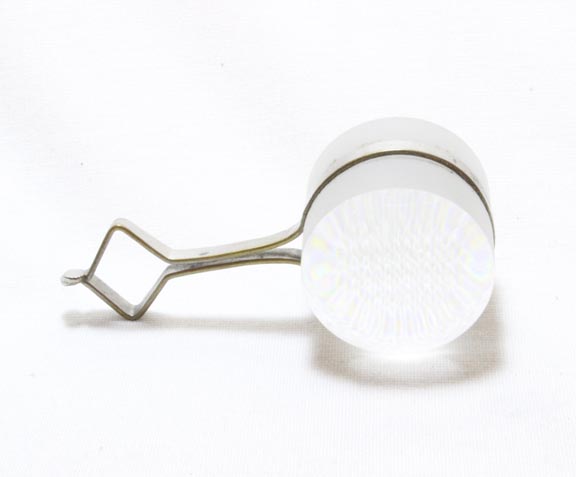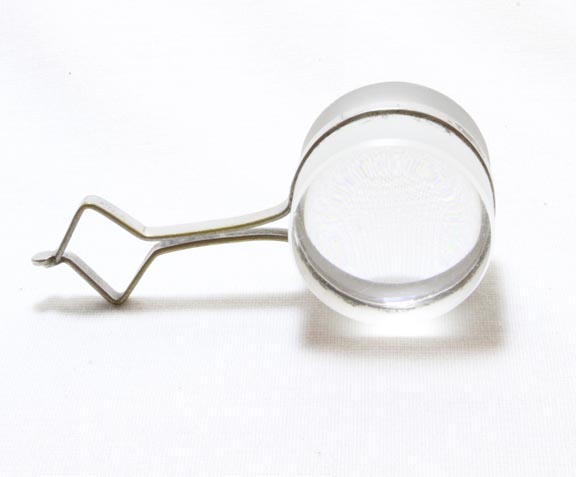DESCRIPTION
 This large Stanhope-type magnifier is made of glass with a nickel-plated brass handle. It is unsigned and bears no hallmark. It is about 96 mm in length. The lens has an outside diameter of about 46 mm and is about 42.5 mm thick. In use this magnifier is used with the flat side down, and placed in contact with the object being magnified. The power is quite low, about 3X. Unlike the original design, this has one completely flat side.
This large Stanhope-type magnifier is made of glass with a nickel-plated brass handle. It is unsigned and bears no hallmark. It is about 96 mm in length. The lens has an outside diameter of about 46 mm and is about 42.5 mm thick. In use this magnifier is used with the flat side down, and placed in contact with the object being magnified. The power is quite low, about 3X. Unlike the original design, this has one completely flat side.
HISTORY OF THE STANHOPE MAGNIFIER OR MICROSCOPE
Charles, the third Earl of Stanhope, invented the magnifier named after him in the late 1700's. The instrument can be made so it is capable of a good degree of magnification, but must be virtully in contact with the subject being studied because of its short focal length. About 1860 the Frenchman Rene Dagron used a modified type of Stanhope lens to show off his microphotographs, often mounting these very ornately. This became a huge and prolific business and what today is commonly known as a 'Stanhope' was born. The lens used by Dagron (and still today), differs from the original Stanhope design in that it has a nearly flat surface in contact with the microphotograph, whereas the original design featured convex surfaces on both ends, though of different curvatures. In the past Dagron's design was sometimes referred to as a 'Stanoscope' but this becomes confusing in modern times a the word has become a registered trademark for a colorometric thickness meter marketed by the Helmut Fischer company. Huge numbers of 'Stanhopes' were made especially by Dagron's company. They were commonly mounted in ivory or bone and often sold as souvenirs. The stand-alone Stanhope magnifier is much less common. The chief advantage of a Stanhope magnifier is its small size, low cost, and relatively high magnification power. Its field of view is a bit larger than some other magnifiers at the same power. The example on this page is of relatively low power and its bottom is flat, unlike the original design featuring a slight curve on the bottom.



 This large Stanhope-type magnifier is made of glass with a nickel-plated brass handle. It is unsigned and bears no hallmark. It is about 96 mm in length. The lens has an outside diameter of about 46 mm and is about 42.5 mm thick. In use this magnifier is used with the flat side down, and placed in contact with the object being magnified. The power is quite low, about 3X. Unlike the original design, this has one completely flat side.
This large Stanhope-type magnifier is made of glass with a nickel-plated brass handle. It is unsigned and bears no hallmark. It is about 96 mm in length. The lens has an outside diameter of about 46 mm and is about 42.5 mm thick. In use this magnifier is used with the flat side down, and placed in contact with the object being magnified. The power is quite low, about 3X. Unlike the original design, this has one completely flat side.